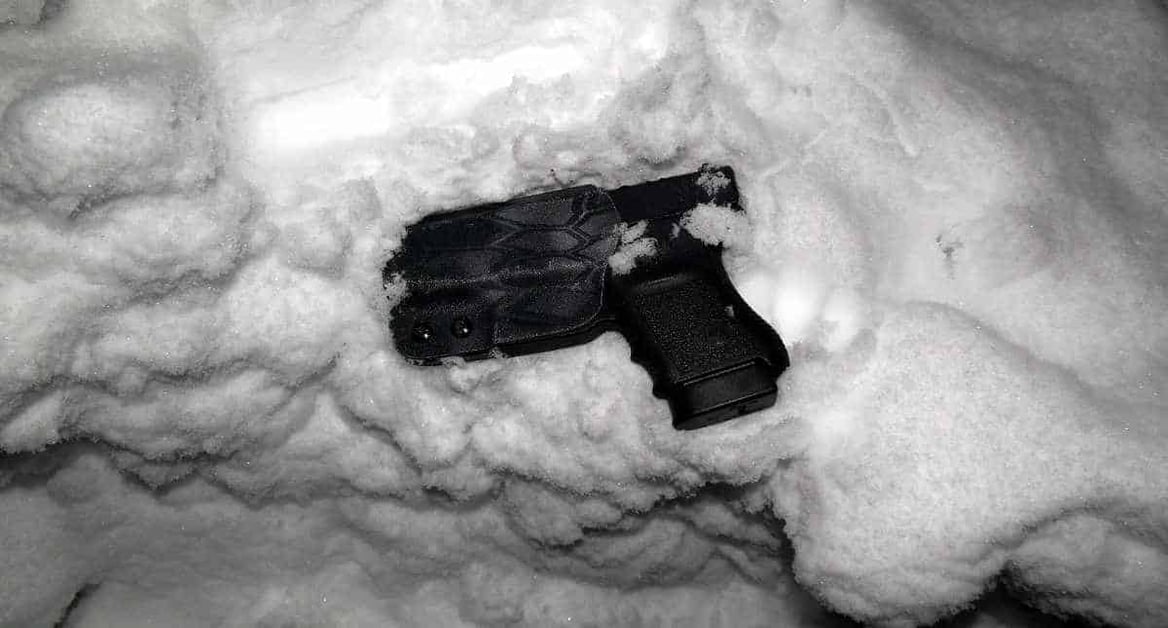A reader recently wrote in and asked us to do a segment on the effects of freezing temperatures on concealed carry handguns. The issue comes up as we head into the deep winter months and temperatures routinely plunge down below freezing. For those who leave a handgun in a vehicle — especially if you work in a place you don’t carry — a natural caution arises if the handgun is left out in freezing conditions.
In most cases, the real issue isn’t going to be the firearm itself. Unless you are dealing with -35° F and your gun is exposed to the elements, you have little to worry about. I’ll address steps I recommend to ensure you minimize any issues.
Sub-Zero Temperatures And Handguns
With a revolver, the main caution is condensation built up around the hammer and the cylinder. We’re talking extremely cold temperatures before these issues will ever appear. The biggest thing you can do to prevent this is remove any excess lubrication you have on the revolver. At extreme cold temperatures (T < 0° F), lubricants begin to gum up. Use only the amount of lubricant you need to clean the firearm and wipe off any excess prior to carrying.
The same is true for pistols. If you expect to run into sub-zero or single digit temperatures, remove any excess lubrication from the pistol. With pistols, you generally have a recoil spring, recoil rod, and a trigger housing group that can become susceptible to gumming up at extremely low, negative temperatures. The chances of these freezing outright is minimal unless they are left exposed to the elements for extended periods of time. Lubricant will become gummy at extremely low temperatures and potentially be a sticking point — no pun intended — if you need to fire the pistol.
Short answer: Keep your lubrication extremely minimal. A dry, cold handgun shouldn’t run into any issues. Keep your pistol insulated and protected from exposure.
NOTE: There are lubricants that are purported to work at extremely low temperatures. I don’t have any personal experience with them so I’m not going to comment on whether or not I can recommend them.
The next big factor is condensation.
Freezing Up Firearms Through Condensation
Air contains moisture. As temperatures drop, the air can no longer hold onto water as well and the water forms a thin solid layer against other solid surfaces. When we talk metal-on-metal contact, this can present a small problem. A handgun CAN freeze or lock up due to condensation build up but generally one of two things will have needed to happen before this becomes a factor.
Two major situations a gun owner may contend with:
- Bringing a gun from a hot environment to a cold one.
Bringing a gun from relative extreme heat (50-70° F) to extreme cold (T < 32° F) can cause a layer of frost to develop on exposed surfaces. If you carry inside the waistband from inside a warm enclosure to the outside, this really isn’t as much of an issue.
Heck, even if you carry in an OWB holster, this isn’t usually a big problem so long as it’s underneath your jacket or an insulating layer.
If you’re outside for lengthy periods of time, so long as your handgun is in an insulated holster or compartment, you should be fine.
If your handgun was sitting exposed to the elements for lengthy periods of time, you would notice frost form. Wipe it off with a dry cloth.
Easy fix: don’t leave your handgun exposed to the elements. If the handgun is not in your direct possession, put an insulating layer around it. If frost forms on the surfaces of your gun, wipe it off with a dry cloth.
- Bringing a gun from a cold environment to a hot one.
Anyone that wears glasses instantly knows the pain of walking into a warm room from the cold outdoors. Your lenses fog up. This condensation can be annoying. However, of the two situations, this one is probably the easiest to fix. Wait until your handgun has warmed up to above freezing temperatures and wipe away any excess moisture. If necessary, disassemble and wipe away any condensation that formed on its internal components.
In almost all cases, handgun malfunctions due to extreme cold weather conditions can be prevented by minimizing exposure to the open cold, using only enough lubricant to clean the firearm, and regularly cleaning and maintaining the firearm to minimize condensation build-up on surfaces.
Have a safe and wonderful winter! Carry everyday, everywhere you can.














